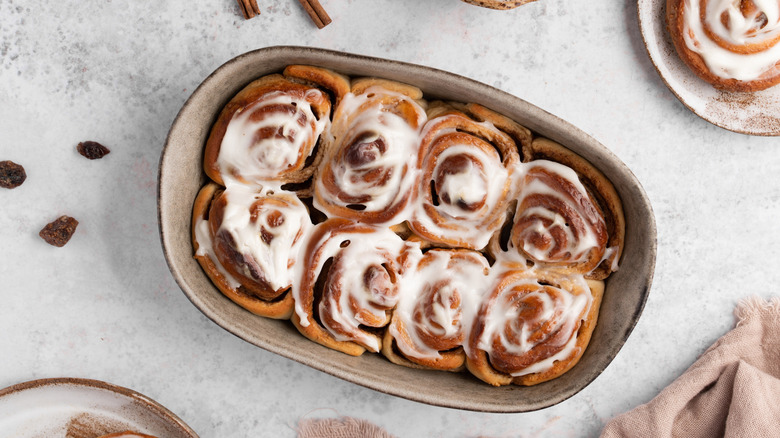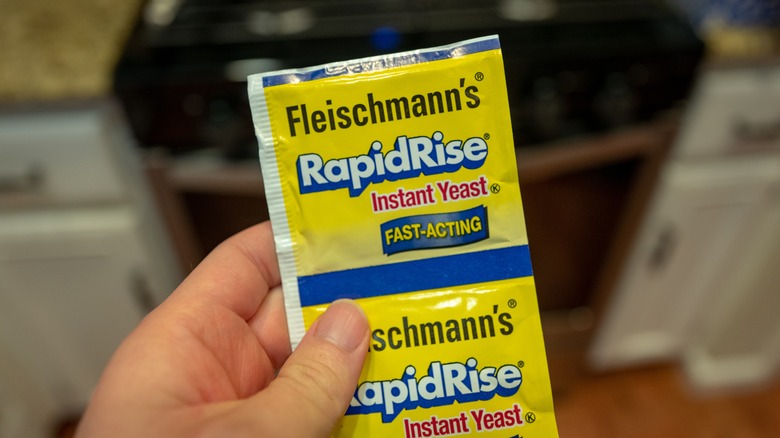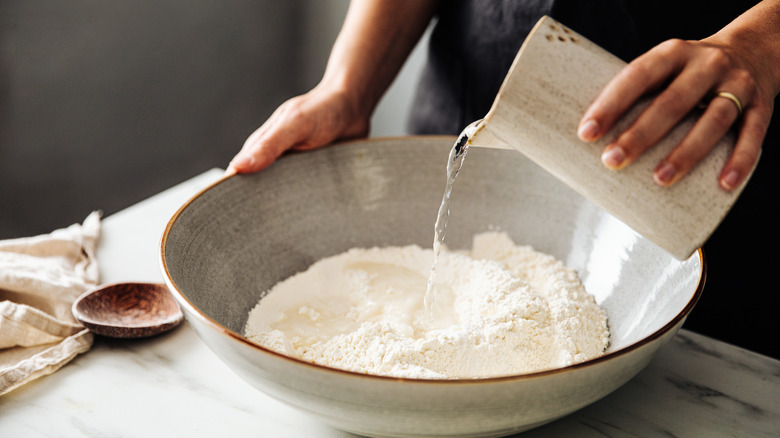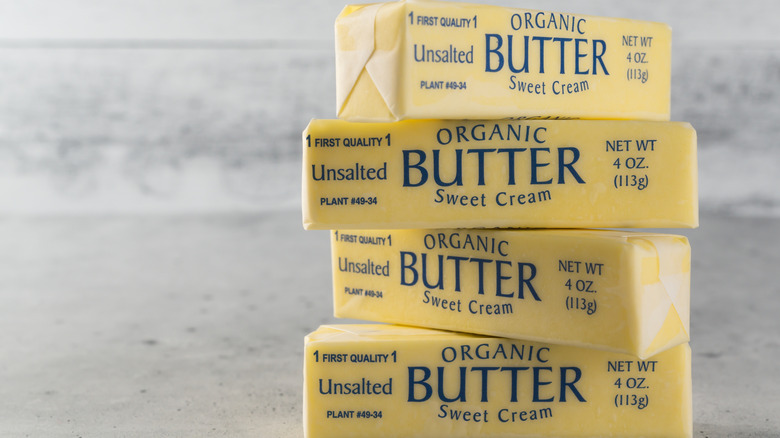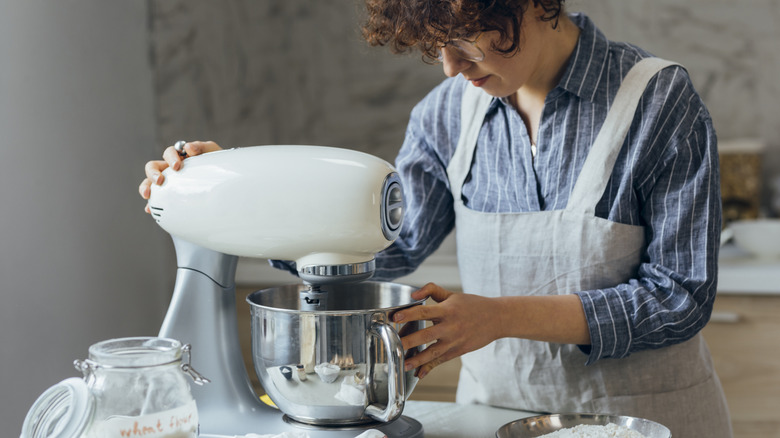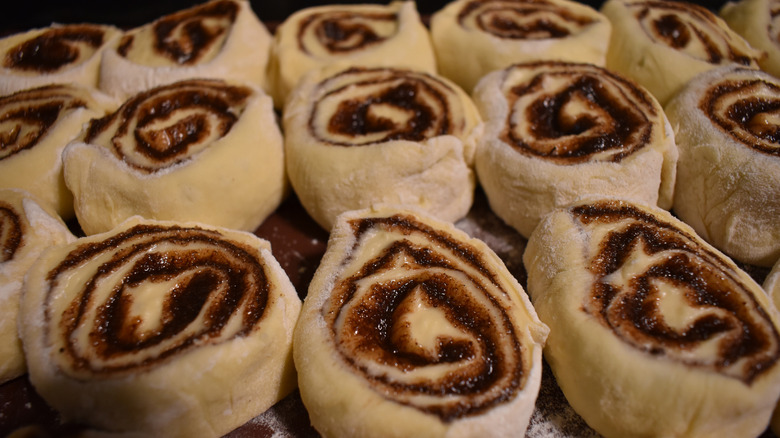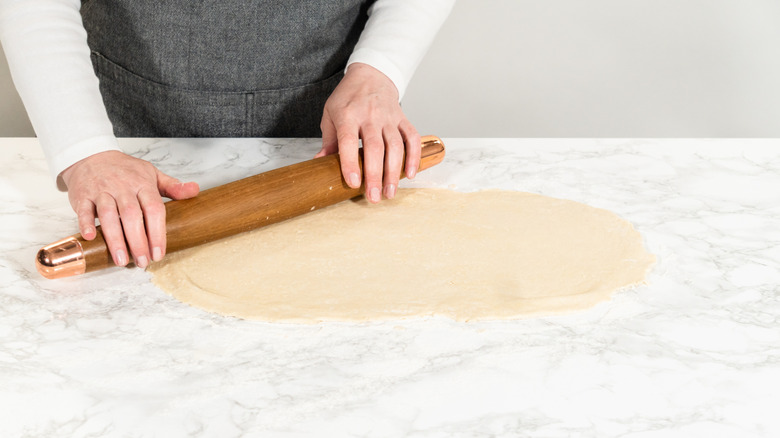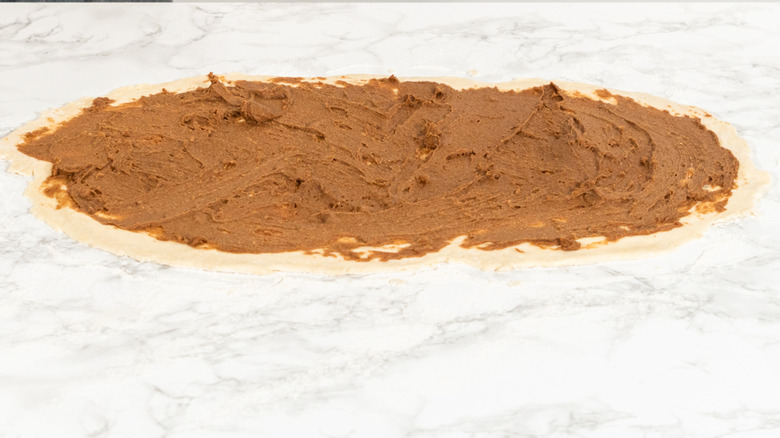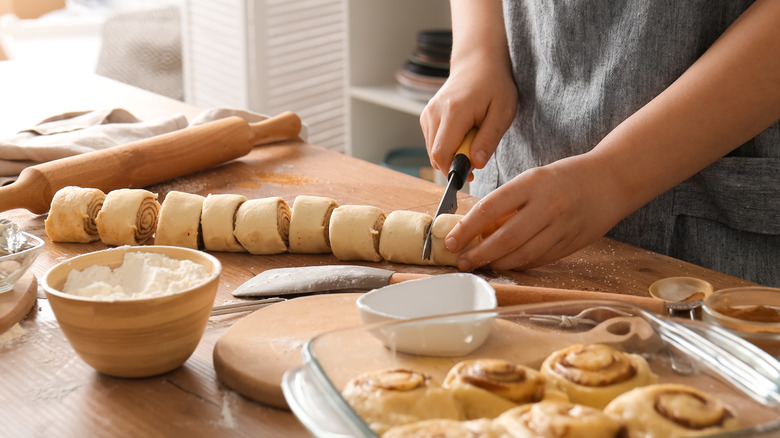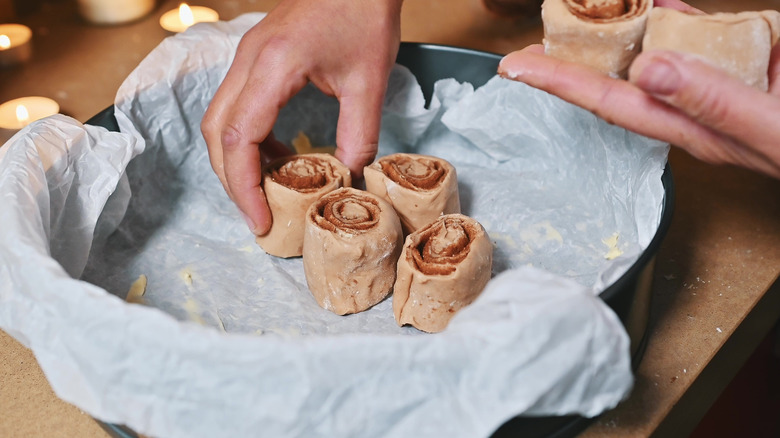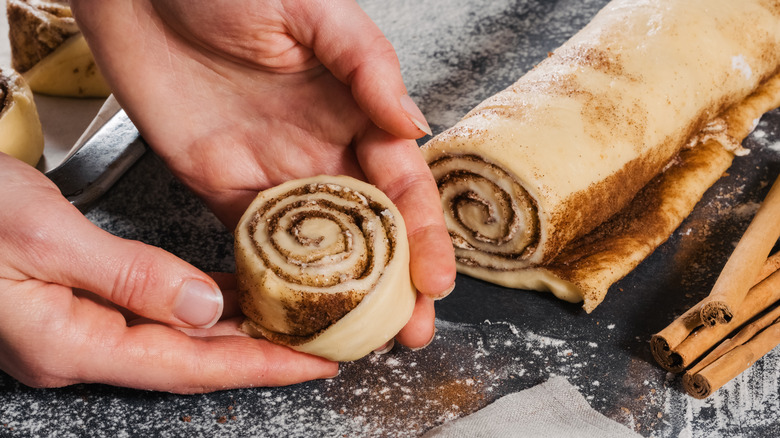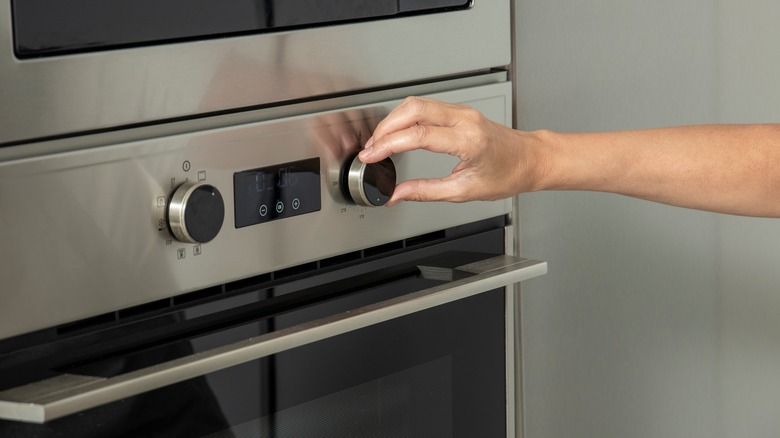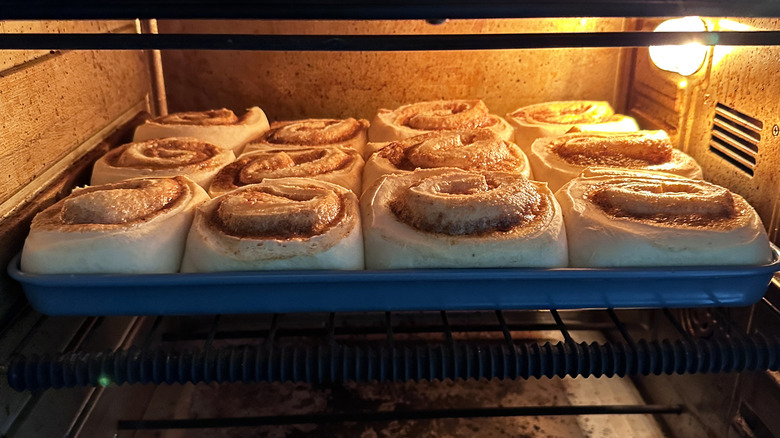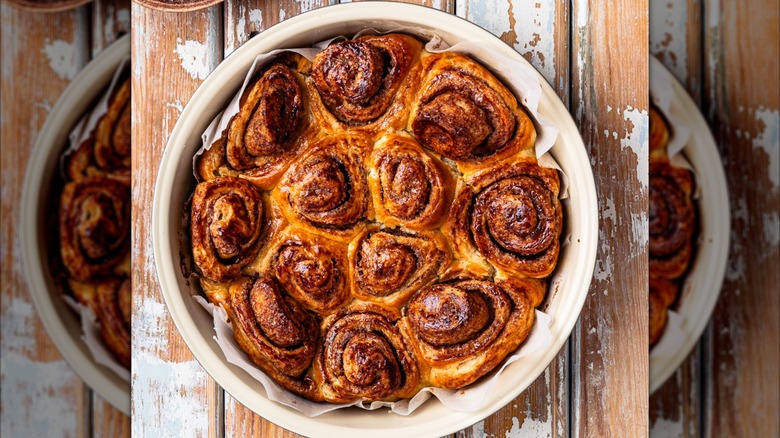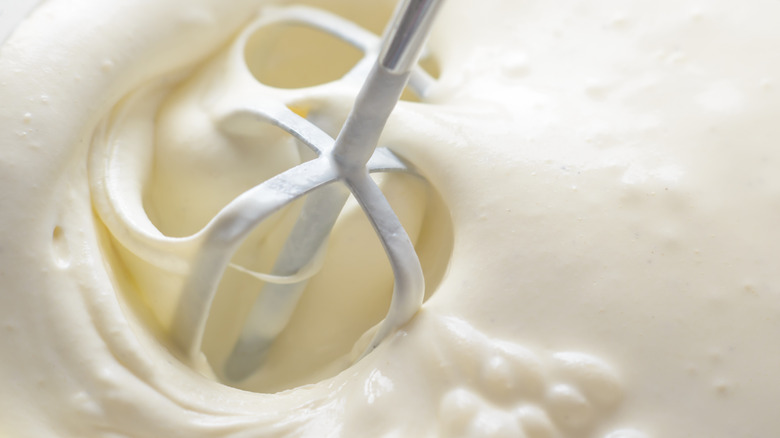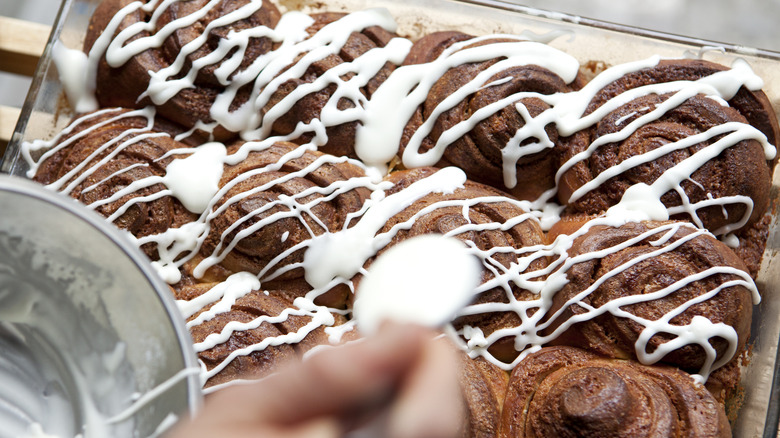Chefs Weigh-In On Mistakes Everyone Makes When Baking Homemade Cinnamon Rolls
We may receive a commission on purchases made from links.
Cinnamon rolls are the quintessential comfort food — even Taylor Swift enjoys making them when her busy schedule allows. While ordering cinnamon rolls from a restaurant or local bakery is always an option, sometimes it's a much better option to make your own. Not only are you able to eat them fresh out of the oven, but you also get to enjoy the incredible aroma throughout the house. Cinnamon rolls, however, aren't exactly the easiest recipe to prepare.
Many home chefs are intimidated by making cinnamon rolls because the recipe might not turn out as expected. While there are several mistakes you can make when preparing homemade cinnamon rolls, these errors can be avoided. We reached out to four expert chefs to help us learn more about these common mistakes and for their best tips on how to avoid them. Vannesa Bordoy is a chef at Poindexter Coffee, Jessica Randhawa is the head chef and recipe developer at The Forked Spoon, Ryan Frye is the executive chef at Washington School House Hotel in Park City, Utah, and Jessie-Sierra Ross is a TV food content creator on NBC, CBS, and PBS, cookbook author of "Seasons Around the Table," and a food & lifestyle blogger at Straight to the Hips, Baby.
Failing to follow the recipe
There are some recipes you can use as a general guideline, making changes and substituting ingredients as you see fit. However, a recipe for cinnamon rolls shouldn't be seen as only a guideline. According to Vannesa Bordoy, chef at Poindexter Coffee, when you're baking pastries, such as cinnamon rolls, you should be very careful to follow the recipe exactly as it is created. "Baking is a science and all the components in it have a very crucial role in the texture and flavor."
Omitting one ingredient because you don't think it is necessary or adding something random to the mix could easily backfire. It could affect the consistency of the dough, impact the rise times, or lead to a runny or gummy mess in the pan. This is especially important advice to follow the first few times you're preparing a new recipe for cinnamon rolls. You want to see exactly how the different ingredients work together. "Once you master it, then you play around with it," explains Bordoy.
Using expired yeast
You can't make homemade cinnamon rolls without yeast; they won't rise. Similarly, you should always check the expiration date on a packet of yeast before using it to make your cinnamon rolls. If you don't bake a lot, that packet of yeast in your pantry may have been there for quite some time and could have expired. Jessica Randhawa, head chef and recipe developer at The Forked Spoon, explains cinnamon rolls won't rise properly if you use expired yeast to make them.
If you can't find an expiration date on the yeast packet, Randhawa shares a tip that can help you ensure the yeast is still active. She says, "If uncertain, proof the yeast by dissolving it in warm water with a pinch of sugar; it should bubble and foam if it's still good." If you don't see any signs of bubbling or foaming, don't risk it. Buy some fresh yeast before attempting to prepare the recipe.
Inadvertently killing the yeast
Using an expired packet is not the only yeast-related problem you could run into when preparing homemade cinnamon rolls. It's also possible to inadvertently kill the yeast as you're preparing the dough. If the yeast gets killed, it will not create carbon dioxide gas, the essential component that causes the cinnamon roll dough to rise.
So, what can kill yeast? One of the main culprits is very hot water. Water that is 130 degrees Fahrenheit or hotter may make the yeast work quicker than it should, impacting the cinnamon rolls' ability to rise. According to Vannesa Bordoy, chef at Poindexter Coffee, if the water or milk is too cold, it can also cause problems. She says, "Make sure to temper to a maximum of 110 degrees and add a pinch of sugar to 'feed' the yeast and help with its fermentation process. Basically, always let the yeast activate!"
Failing to soften the butter before mixing
Did you know the importance of butter temperature when baking? If not, you might learn the hard way if you fail to soften the butter before mixing your cinnamon rolls. Ryan Frye, executive chef at Washington School House Hotel in Park City, Utah, explains, "This will make clumps of butter that melt out instead of blending in."
It's important to plan ahead for this one. "A lot of times we'll forget about it and take it out at the last moment, trying to melt it before we add it in and the result is not the same (and it's usually too liquid in consistency when you do this)," shares Poindexter Coffee chef Vannesa Bordoy. Both Bordoy and Frye recommend letting the butter sit out for a couple hours — or even overnight in a covered container — to ensure it is properly softened and ready to incorporate into the dough. You can try to use a rolling pin to soften butter in a pinch — but you'll achieve much more consistent results by planning ahead and taking it out before you're ready to start cooking.
Overworking the dough
Kneading the dough is an essential step when making homemade cinnamon rolls. It helps dough reach the ideal texture and consistency, ensures the gluten develops properly to trap the carbon dioxide and helps cinnamon rolls rise properly — and guarantees all of your ingredients are evenly distributed. But overworking the dough can be a really big mistake when you're preparing cinnamon rolls. If you overwork it, you'll develop too much gluten. This can make the dough tacky and hard to work with. It may also end up cracking and ruining your cinnamon rolls.
"With kneading, don't worry about your dough being flat and perfect — homemade cinnamon rolls or any other pastry sometimes needs a little less perfection," explains Vannesa Bordoy, chef at Poindexter Coffee. Jessica Randhawa agrees and also cautions against overworking the dough. She says, "Mix and knead the dough just until it's smooth and elastic, but no longer than necessary to avoid developing too much gluten."
According to Bordoy, manually kneading cinnamon roll dough should take between 10 and 15 minutes, or between five and seven minutes if you're using a stand mixer. She notes the dough should have a puffy and soft look after it has risen the first time. "When kneading the second time, we don't want to squeeze out the air and it shouldn't feel like a workout for you either," Bordoy adds.
Not allowing your dough ample time to rise
Many people make the mistake of not giving their cinnamon roll dough enough time to rise. Jessie-Sierra Ross, cookbook author and TV food content creator on NBC, CBS, and PBS, explains what happens when the dough rises. She says, "As the yeast consumes the sugars in the dough, they release gases that create tiny pockets of air. If we don't allow the yeast enough time to do its magic, the cinnamon roll dough will be dense and flat."
To ensure the best taste and texture, Jessica Randhawa, head chef and recipe developer at The Forked Spoon, explains, "It's important to let the dough double in size during the first rise, and after shaping the rolls, allow them to rise again until puffy and nearly doubled." According to Ross, you can also confirm if the dough has risen enough by pressing gently on it. She says, "If you can make a dent that stays when your finger is removed, it's ready to roll. Literally."
Not rolling out the dough properly
So, you've made it through the challenge of working with the yeast and ensuring your cinnamon roll dough rises properly. Now, it's all smooth sailing ahead, right? Unfortunately, that's not the case. You can also make serious mistakes when rolling out cinnamon roll dough. "Not rolling your base dough thin enough can create thick, sponge-like cinnamon rolls," cautions cookbook author Jessie-Sierra Ross. She recommends working with the dough on a floured-surface and rolling it out into a long, oval-like shape until it's about ¼-inch thick.
Jessica Randhawa, The Forked Spoon, highlights another dough-rolling mistake to avoid. "The dough should be rolled out to an even thickness to ensure that each roll cooks uniformly and has a consistent texture. If the dough is too thick in some places, those parts won't cook through, leaving you with doughy sections." She also recommends a thickness of ¼-inch.
Not filling the rolls properly
After you've rolled out the dough for your cinnamon rolls, you're ready to start filling them. According to Jessie-Sierra Ross, cookbook author and TV food content creator on NBC, CBS, and PBS, this is another step that requires precision to avoid a catastrophe. She explains, "If too much filling is added, the rolls won't stay formed in a nice tidy package, but adding too little filling can make for a disappointingly 'bread-y' pastry."
To avoid either of these problems, she recommends thinking of the filling as two different components that need to work together. The first, Ross says, is the butter base. "Proper rolling really depends on proper filling, so spread your softened butter across the rolled-out dough, leaving about a ½ inch border plain," she explains. Once the softened butter is spread properly, you're ready to move onto the cinnamon-sugar topping. Ross adds, "Sprinkle the cinnamon and sugar evenly across the buttered area, while leaving the border bare. This helps to contain the filling as you roll up the cinnamon rolls."
Failing to cut the rolled dough into even slices
If you want your cinnamon rolls to bake evenly, it's essential to make sure they're cut into slices of the same thickness. If some slices are thicker and/or thinner than others, some of your rolls may still be doughy, while others are overbaked and too hard.
To avoid this problem, Poindexter Coffee chef Vannesa Bordoy says, "I always recommend using a ruler to mark your dough and using a sharp serrated knife (a regular blade will always squish your roll)." She mentions that you could try an adjustable roll slicer — such as the Ateco 5-Wheel Stainless Steel Cutter — to ensure uniform slices or even use some dental floss to create clean cuts without squishing the dough.
Forgetting to consider spacing
When you're ready to put your sliced cinnamon rolls in the pan, space them out thoughtfully. According to Jessica Randhawa, head chef and recipe developer at The Forked Spoon, this can have a significant impact on the consistency of the rolls once they have finished baking. She explains, "Placing rolls too close together in the pan means they will rise and bake into each other, becoming more like a cake in texture, whereas too much space can cause them to become dry or overly crisp."
Ryan Frye, executive chef at Washington School House Hotel, shares a general rule to follow when spacing out the rolls. He says, "Put the rolls 2-3 inches apart so that they can proof and bake into one another to help with stability and rise." This way, once the cinnamon rolls have finished baking, they won't be overly cake-y or doughy, but also won't be too crisp that you miss out on that must-have soft and gooey cinnamon roll texture.
Forgetting to tuck the tails
Ryan Frye, executive chef at Washington School House Hotel, highlights one additional mistake many people make when putting their cinnamon rolls in the pan. He says, "If you want crisper edges (and not pull apart style), make sure that the tail of the roll is tucked under so that they do not unravel during baking." An unraveled cinnamon roll will not only be poorly shaped, but it will also be more difficult to remove from the pan or to eat without making a big mess.
Tucking the tails may introduce another potential problem. When you place the tail under the roll, it might not stay flat. The finished cinnamon roll might look a bit less-professional if it turns out lopsided. To easily avert this, simply taper the end of the tail before you cut it. Use a serrated knife to trim off a small triangle from the end. Now, the tail will fit under the rest of the roll without interfering with its ability to sit flat on the baking sheet.
Skipping the step of preheating the oven
Failing to preheat the oven is a mistake people make when baking a cake or cooking cinnamon rolls and other pastry-like items. Jessie-Sierra Ross, cookbook author and TV food content creator on NBC, CBS, and PBS, highlights the importance of preheating an oven when making baked goods. She explains that the hot oven "starts the chemical process of activating your leavening (such as yeast, baking powder, baking soda, etc.), as well as creating the most consistent baking environment for your recipe."
When you skip the step of preheating the oven, the outside of each cinnamon roll is going to cook quicker than the center. If this were to happen, Ross explains, "The pastry would end up denser, and lose that distinctive fluffiness we all enjoy." She recommends giving the oven at least 15 minutes to come to temperature before you try to bake your cinnamon rolls.
Baking the rolls at the wrong temperature or for the wrong time
Not only must the oven be preheated before you start baking your cinnamon rolls, but it also must be heated to the ideal temperature. "Too hot an oven can cause the outside to burn before the inside is cooked, while too low a temperature can result in undercooked rolls," explains Jessica Randhawa, head chef and recipe developer at The Forked Spoon. While most recipes will likely call for an oven temperature between 350 and 375 degrees Fahrenheit, each cinnamon roll recipe may vary slightly. Be sure to consult the directions for the one you're following before setting the oven.
Some ovens run hot or cold. Randhawa recommends monitoring and adjusting the bake time if you know your oven is prone to running hotter or colder than what you set it to. If you're not sure how accurate the thermostat in your oven is, you can purchase an oven thermometer, such as the Taylor Large Dial Oven Thermometer, to help you verify you're actually baking cinnamon rolls at the ideal temperature.
Under- or over-baking cinnamon rolls
While a recipe provides an estimated baking time, we've already explained how the temperature of your oven may be slightly off. Therefore, it's essential to monitor the progress of the cinnamon rolls as they bake and remove them once they're ready — not too soon or too late. "There is definitely a 'sweet-spot' when it comes to baking up the perfect tray of cinnamon rolls. Overbaked pastry is tough and dry, and not at all what we imagine a cinnamon roll to be. On the other end, if you pull the batch from the oven too soon, the dough will end up wet and gummy," explains Jessie-Sierra Ross, cookbook author and TV food content creator on NBC, CBS, and PBS.
To avoid under- or over-baked cinnamon rolls, Ross emphasizes the important of placing the rolls on the middle rack in a preheated oven. This placement, she says, will deliver the most even heat distribution. She recommends peeking on the progress of the rolls about five minutes before the recipe says they should be done. Finally, she also notes how a thermometer, such as the ThermoPro Digital Thermometer, can help you check for doneness. When ready, cinnamon rolls should register a temperature between 190 and 200 degrees Fahrenheit.
Making the icing overly sweet
"Whether you use a simple blend of confectioner's sugar, milk, and vanilla extract to create a glossy icing, or whip up a creamy cream cheese frosting, it's important to use the right ratio of sweetness," shares cookbook author and TV food content creator Jessie-Sierra Ross. She cautions against overwhelming the cinnamon roll by making it overly sweet, and instead says you want to make sure that it perfectly complements the other flavors in the baked good.
While you could try to upgrade a can of frosting to use for your cinnamon rolls, you might be better off starting from scratch to avoid making something too sweet. Cream cheese frosting pairs beautifully with cinnamon rolls. While still tasty, it isn't quite as sweet as buttercream and will be less likely to over power the other flavors in the roll. The icing is also easy to make using just some cream cheese softened in the microwave, butter, powdered sugar, milk, and vanilla. If you do decide to make buttercream frosting and it turns out too sweet, you can try to balance the flavor by adding in a little lemon juice to cut the sweetness a tad.
Frosting too soon — or too late
Did you know frosting your cinnamon rolls could also turn out to be a mistake? "If you frost the rolls while they are too hot, the frosting will melt and run off, leading to a sticky mess rather than a delightful treat," says Jessica Randhawa, head chef and recipe developer at The Forked Spoon. "Conversely, frosting them when they are too cool might prevent the frosting from melting into the rolls, making them less flavorful."
She recommends letting the cinnamon rolls cool for just a few minutes after removing them from the oven. But, don't let them cool too long; they should still be warm enough to ensure the frosting melts a little so that it's flavor is really infused into each bite. A cooling period between five and 10 minutes should help you arrive at that "sweet spot" where the rolls aren't so hot that they melt all the frosting or too cold that it just clumps on top of them when you try to ice them.
